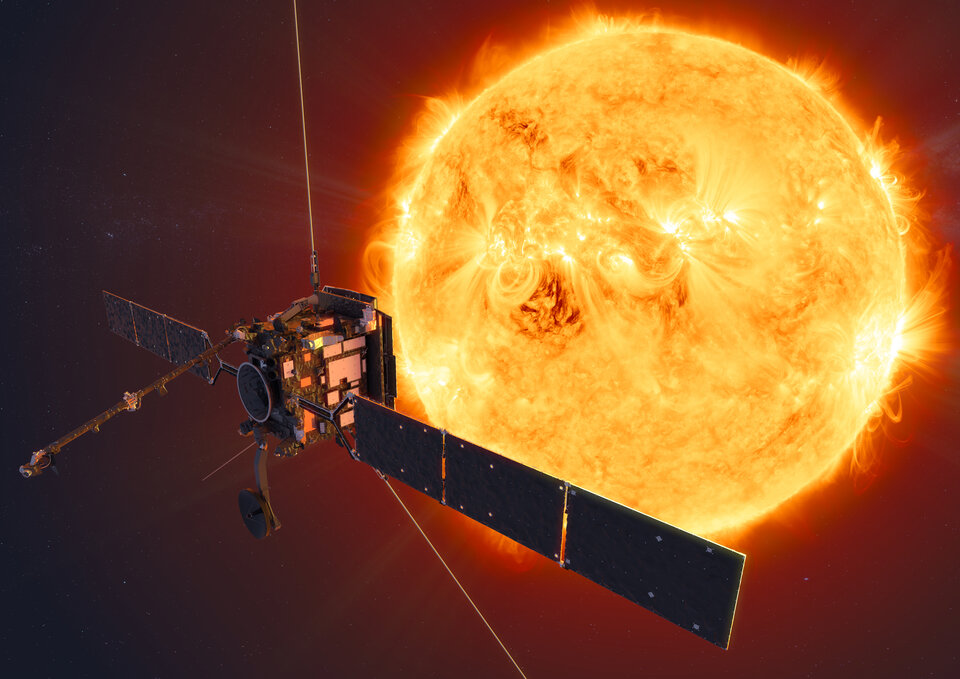Harvest of scientific results for the Solar Orbiter mission
For a mission that has just entered its primary science phase, Solar Orbiter has already produced many remarkable results. Published on December 14, 2021, a special issue of Astronomy and Astrophysics brings together a multitude of studies and observations obtained during the cruise phase of the mission. No less than 56 articles have been published, each containing data produced by one or several instruments on which the French scientific community has been strongly involved, including several CNRS laboratories.
The cruise phase of Solar Orbiter began on June 15, 2020 and lasted until November 27, 2021. During this time, the probe acquired scientific data with its in situ instruments, designed to measure the environment around the spacecraft. It also used its remote sensing equipment to characterize and calibrate these instruments by observing the Sun. Some of this data proved to be of such high quality that it enabled the first scientific studies to be undertaken ahead of the main science phase, which began in late November 2021.

After a launch in February 2020 and a 21-month journey of nearly two billion km, the probe used the Earth’s gravitational assistance one last time on November 27, before starting the nominal phase of its mission, with a first pass at 0.3 astronomical units at the end of March 2022 (about the distance of Mercury when it is closest to the Sun). During this cruise phase, mainly used to start up, test and calibrate the ten instruments of the probe, the data collected proved to be of such a quality that they allowed to undertake several first scientific studies, before the main scientific phase.
Thus, the RPW (1) instrument, which measures electric and magnetic waves in the inner heliosphere, has made it possible to obtain the first simultaneous observations with four different probes, including Solar Orbiter, of a type III solar radio emission (Musset et al.). These radio emissions are produced by energetic electrons injected in the heliosphere during solar flares. The instrument also allowed to study the interplanetary dust rate along the orbit of the probe and to show that the studied dust population moves away from the Sun at a speed of about 50 km/s. (Zaslavsky et al.). RPW was also able to measure the waves associated with the tail of the comet ATLAS (Matteini et al.), as well as with the Venus magnetosphere (Hadid et al.), both encountered during the Solar Orbiter trip around the Sun. It also produced a first mapping of plasma waves observed in the solar wind between 0.5 and 1 astronomical unit (Kretzschmar et al., Chust et al., Pisa et al.)
The cruise phase was also an opportunity to test the operation of the STIX (2) spectro-imager which measures the X-ray emissions produced in the solar atmosphere by electrons accelerated during flares. It thus makes it possible to establish a link between the imaging of the solar atmosphere and the in situ measurements: radioelectric emissions of the electron beams propagating in the upper solar atmosphere detected by RPW, and local measurements of the solar electrons injected in the interplanetary medium. The results produced during the cruise phase concern the observations of X-ray micro-eruptions which allowed to test the performances of the instrument at its detection limit (Battaglia et al.)
The SWA instrument, composed of 3 sensors adapted to the measurement of different types of particles (PAS (3): Protons and Alphas, EAS: electrons and HIS: heavy ions), has allowed observations at a rate 100 times faster than the HELIOS probes. The results concern as much large scale phenomena: alfvénic slow winds (D’Amicis et al), Kelvin-Helmholtz instability (Kieokaew et al), magnetic reconnection effects (Fedorov et al, Owen et al, Lavraud et al), solar wind angular momentum variations (Verscharen et), as microscopic processes associated with the fine organization of distribution functions (Louarn et al).

The first EUI (Extreme Ultraviolet Imager) (4) observations immediately provided some of the finest images ever obtained of the solar corona (Berghmans et al., Zhukov et al.). These images revealed bright structures at very small scales (400 km on the Sun for the smallest) which seem to be the signature of the ‘nano-eruptions’ imagined by E. Parker more than 20 years ago to solve the problem of the heating of the solar corona: how to explain that the atmosphere of our star has a temperature of more than one million degrees while its surface is only at 5000 degrees? The main characteristics of the events observed by EUI are in good agreement with the MHD models (Chen et al.). However, these high-resolution observations obtained during the in-flight acceptance phase lasted only 5 minutes and do not allow the statistical study necessary to establish whether the nano-eruptions alone can maintain the temperature at a high level. Dedicated observations are therefore planned for the next perihelion, during which the spatial resolution will be more than twice as good.
The SPICE (5) spectrograph has been designed to provide maps of the chemical composition of the Sun’s atmosphere, in order to identify the sources of the solar wind by comparison with composition measurements made in situ. SPICE observations during the flight acceptance phase identified bright spots of unusual intensity and duration (Fludra et al.). It is possible that there is a link between these structures and those observed by EUI (see above). Again, the observations of the first near perihelion are highly expected.
Notes
- Designed and built by an international consortium led by an integrated team LESIA-Observatoire de Paris PSL, CNES, LPC2E and LPP
- On which CEA and LESIA are involved
- Provided by the IRAP of Toulouse
- Carried out by an international consortium with a strong contribution from IAS (co-PI, responsible for the wide field channel) and the Institute of Optics.
- Carried out by an international consortium for which the IAS took over the responsibility of the consortium after the launch of the mission.
IRAP Contact
- Philippe Louarn, philippe.louarn@irap.omp.eu






